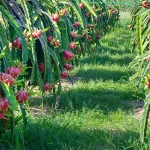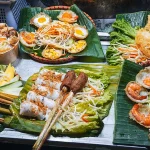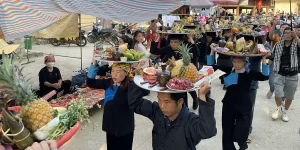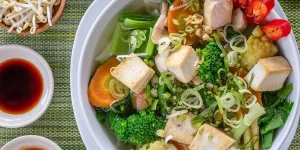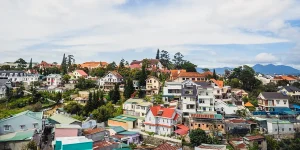Vietnamese fruits are part of daily life in every region of the country. A fruit that releases sweet white sap when pressed, or another with a smell strong enough that some hotels ask guests not to bring it inside, are normal finds in markets and roadside stalls. For travelers, the main surprise is not that fruits are everywhere, but that many varieties are rarely sold fresh at home.
Vietnam’s climate ranges from cool highlands to humid river deltas, so harvest seasons overlap and change as you move north or south. That means a short trip can cover a wide range of Vietnam fruits if you know what to look for and when.
For international travelers, the value of exploring Vietnam fruits is practical as well as cultural. Many of these fruits are not exported fresh at scale, so even people who have tried “tropical fruit” at home usually meet new varieties in Vietnam. Prices are also low by global standards, which makes it easy to taste widely without turning fruit into a splurge.
This guide gives a clear list of fruits to try in Vietnam, where they grow best, and how locals actually eat them. It also covers the most reliable places to buy fruit, the seasons that matter most for taste and price, and a few safety notes that help avoid stomach trouble.
Quick note:
Prices in our fruit guide reflect typical market averages, but they can fluctuate a lot by region, season, and short-term supply.
Table of Contents
How Vietnamese People Really Eat Fruits (and why it’s nothing like Europe or the US)

Before exploring exotic Vietnamese fruits, it helps to understand how they fit into local life. In most households, they are everyday snacks eaten at different points in the day, not a formal dessert after dinner. People pick them up on the way to work, eat them mid-morning, or carry a small bag of pre-cut pieces for an afternoon break.
Salty Fruits
A common habit is pairing fruit with a premade dipping mix. Vendors sell small packets combining salt, chili, and sometimes a little sugar or dried shrimp. Locals use this mix on crisp or mildly sweet fruits such as guava, green mango, or rose apple. The added kick is a familiar part of everyday fruit snacking in Vietnam.
The Five Fruit Tray
Fruit also plays a role in rituals. During Tet (Vietnamese Lunar New Year), many families prepare a mâm ngũ quả (five-fruit tray) on home altars to honor ancestors. The exact fruits vary by region, but the idea is the same. Because of this, certain Vietnamese fruits become more expensive near Tet due to demand for gifting and altar displays.
Best Places to Buy Fruits in Vietnam
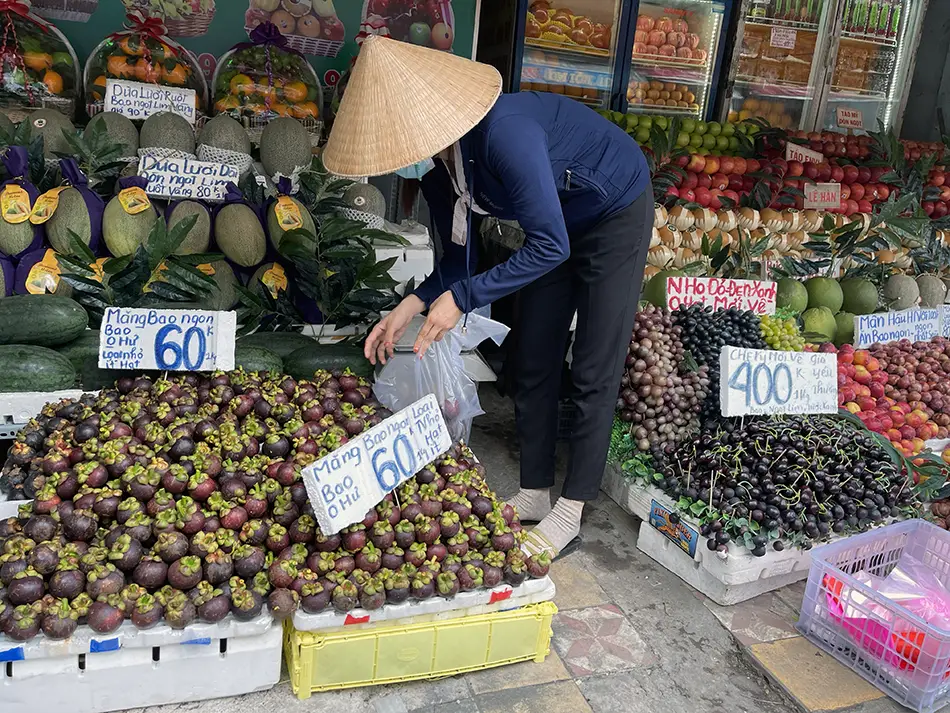
If your goal is to taste the freshest Vietnamese fruits, morning wet markets are the most reliable starting point. They open before sunrise and thats where local families shop. Prices are usually lowest here because fruit arrives from farms early and sells quickly. These markets also sell a wide range of plant-based snacks that are central to Vietnamese vegetarian food.
Night markets also sell fruits, often pre-cut and served in cups, alongside a wide mix of Vietnamese street food. These are convenient for short stops, but the selection is smaller, the fruits may be less fresh than morning stock, and prices are higher.
Roadside stalls are another major part of the fruit system. On highways near farms, you will see fruit sold directly from orchards. In the Mekong Delta, stalls often carry rambutan, longan, durian, mangosteen, pomelo, and jackfruit during harvest months. Along the central coast, piles of dragon fruit are common year-round. The advantage is freshness and price.
12 Fruits You Must Try in Vietnam
Dragon fruit (thanh long)

Dragon fruit is a cactus-grown crop with a thick pink or yellow skin and white or red flesh dotted with small black seeds. Vietnam exports it in large volumes, and the main growing regions now include the former Bình Thuận area, along with Long An and Tiền Giang provinces. It is available year-round, with the strongest harvest from July to December.
Locals usually slice dragon fruit chilled and eat it plain. Because the flavor is mild, it is often blended into smoothies with lime or yogurt.
Average price: 30,000 VND per kg ($1.14 / €0.99).

Fun Fact
Farmers in central Vietnam use electric lights at night to extend flowering and harvest outside peak months, which is why dragon fruit still appears in markets even in cooler seasons.
Rambutan (chôm chôm)
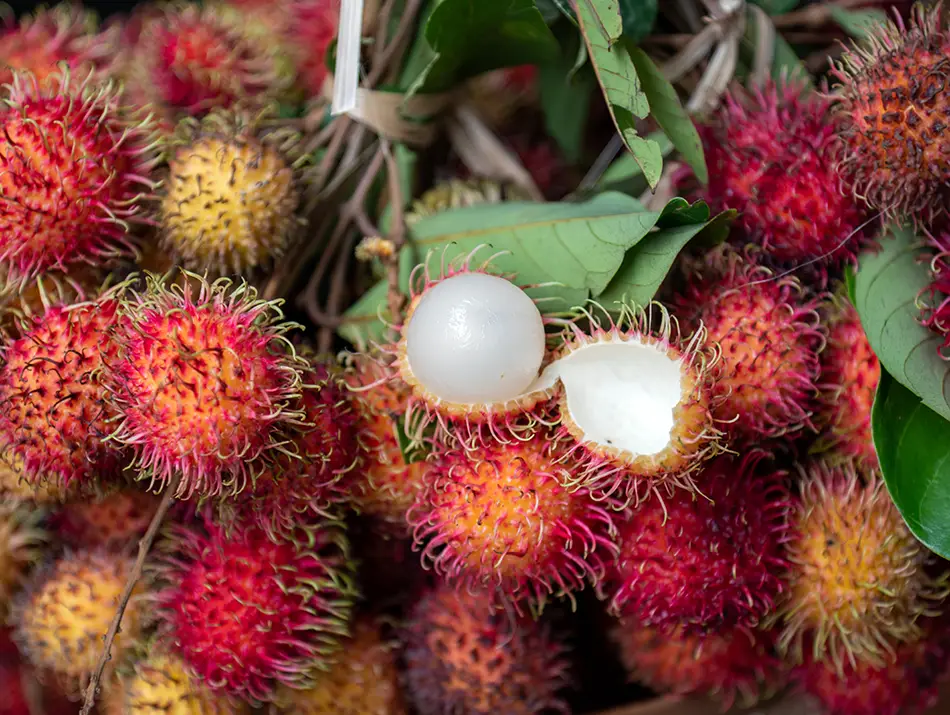
Rambutan has a red or yellow rind covered in soft spines and a translucent white flesh, similar in structure to lychee. Among strange Vietnamese fruits, rambutan is one of the easiest to try because it peels cleanly. The main season runs from May to August, especially in the Mekong Delta and southeastern provinces.
Locals peel rambutan by hand, splitting the rind along a seam, then eat the flesh and discard the seed. It also appears in mixed fruit cups and sweet soups sold in markets.
Average price: 30,000 VND per kg ($1.14 / €0.99).
Mangosteen (măng cụt)

Average price: 65,000 VND per kg ($2.47 / €2.14).
Mangosteen is round with a thick purple rind and segmented white flesh inside. For travelers looking for the freshest exotic Vietnamese fruits, mangosteen is strongly seasonal, which makes timing important. The main harvest is May to August, centered in southern provinces such as Ben Tre, Vinh Long, and Binh Duong.
To eat it, locals cut a shallow ring around the middle of the rind, twist it open, and lift out the segments. The rind stains easily, so hands and clothing can pick up purple marks. Early-season mangosteen is usually smaller and costs more, while peak-season fruit is cheaper and sweeter.
Fun Fact
Some hotels restrict mangosteen in rooms because the staining from its rind is extremely difficult to remove from fabric.
Durian (sầu riêng)

🏆The King of Vietnam’s Weird Fruits to Try
Average price: 70,000 VND per kg ($2.66 / €2.30).
Durian is large, spiky, and known for dense, creamy flesh and a very strong odor. It is often called the “king of fruits,” and reactions vary widely. Some people search for it, some grow up eating it, and others cannot tolerate the smell at all. The main season is June to August in the south and Central Highlands, with shorter harvest windows in the north.
The smell becomes intense only after the fruit is opened, because the soft flesh releases sulfur-based compounds into the air. Once exposed, the odor clings to fabric and enclosed spaces for hours, which is why durian is banned in many hotels, buses, taxis, trains, and most airlines. Locals often buy a whole fruit and have the vendor open it immediately, or they purchase cleaned pods to avoid the mess and lingering scent.
Star apple or milk fruit (vú sữa)
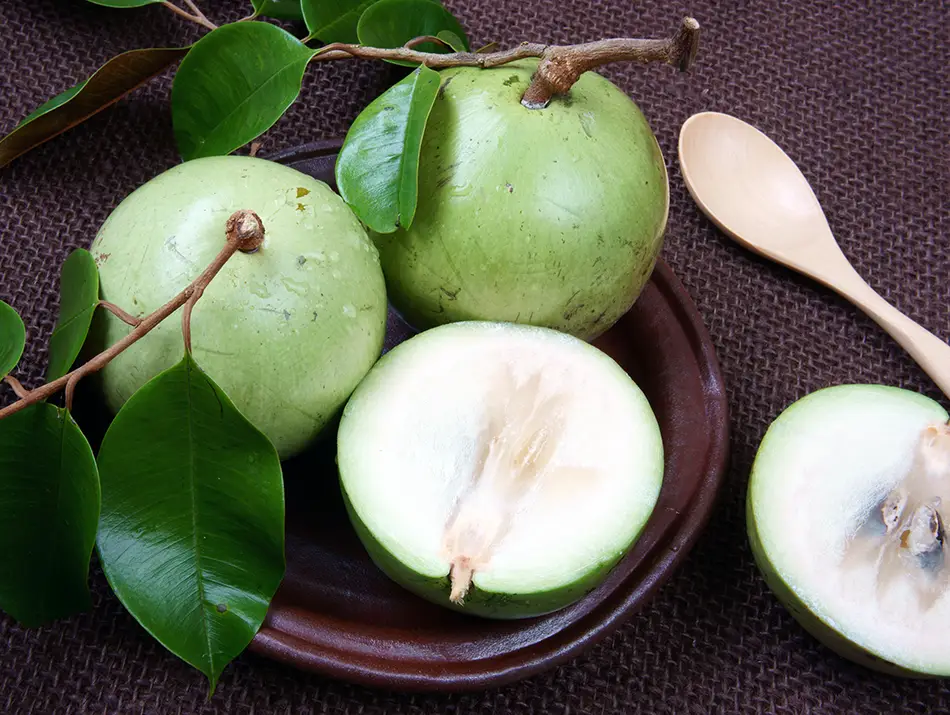
Average price: 55,000 VND per kg ($2.09 / €1.81).
Star apple has green or purple skin and soft white flesh that releases milky sap when pressed. It is one of the Vietnam fruits that don’t exist in Europe or the USA in fresh form. The fruit is linked to southern Vietnam, especially Tien Giang and nearby provinces. The main season is November to January, often extending into March.
Locals roll the fruit gently between their palms to soften it, then cut it open and eat with a spoon. The outer skin is not eaten. The milky latex is normal and is part of why the fruit has its English nickname.
Soursop (mãng cầu)
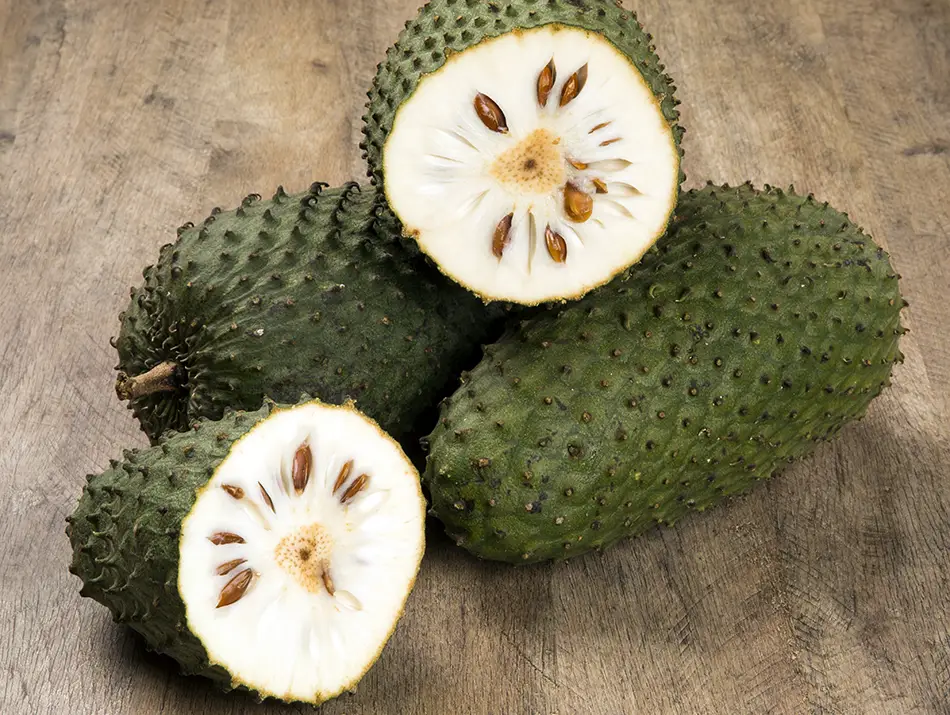
Average price: 45,000 VND per kg ($1.71 / €1.48).
Soursop has green skin with soft spikes and white fibrous flesh studded with black seeds. It grows widely and is sold most of the year, so it is one of the easiest fruits in Vietnam to find outside peak seasons.
Many locals use soursop for juice, smoothies, or sweet soups rather than eating it plain. When buying fresh soursop, look for slight softness. Overripe fruit becomes very soft and ferments quickly in heat.
Custard apple or sugar apple (na)

Average price: 45,000 VND per kg ($1.71 / €1.48).
Custard apple has bumpy green skin and soft, aromatic flesh with glossy black seeds. The typical season runs from September to December, especially in northern and central provinces.
Locals split it open and eat sections by hand, removing seeds as they go. The fruit bruises easily, so piles late in the season may include dented pieces.
Rose apple or wax apple (roi or mận)
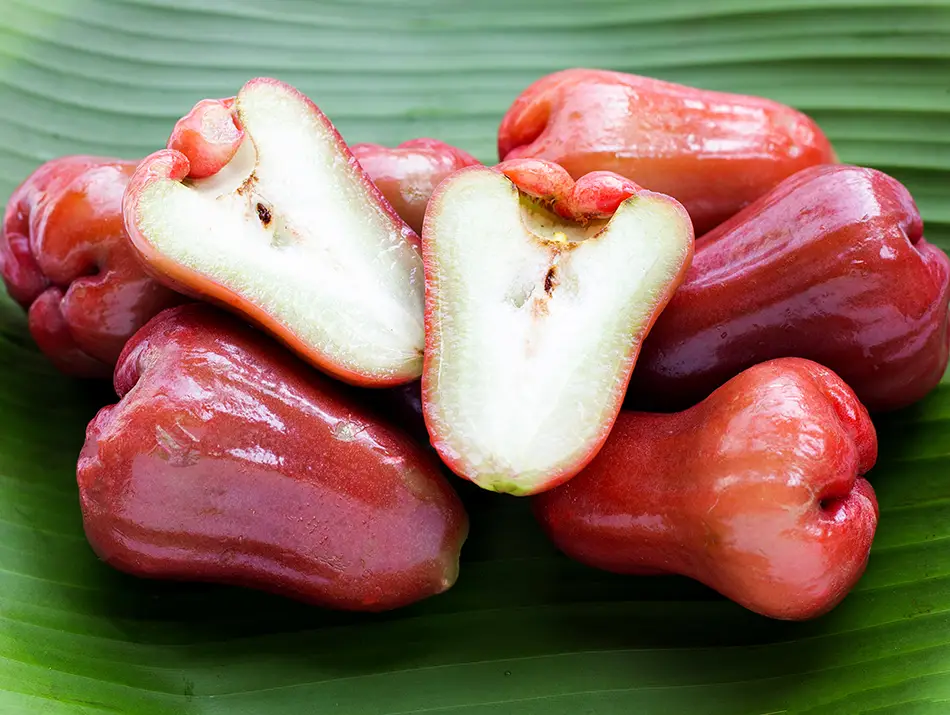
Average price: 25,000 VND per kg ($0.95 / €0.82).
Rose apple is bell-shaped with crisp, watery flesh. The Vietnamese names can overlap with “plum” in translation, so you may hear both. For travelers exploring Vietnamese fruits, this is a common street snack because it stays crisp in heat.
Rose apple is eaten raw, often with muối ớt (chili-salt dip). It appears in markets much of the year, with stronger supplies from November into early summer in the south.
Longan (nhãn)
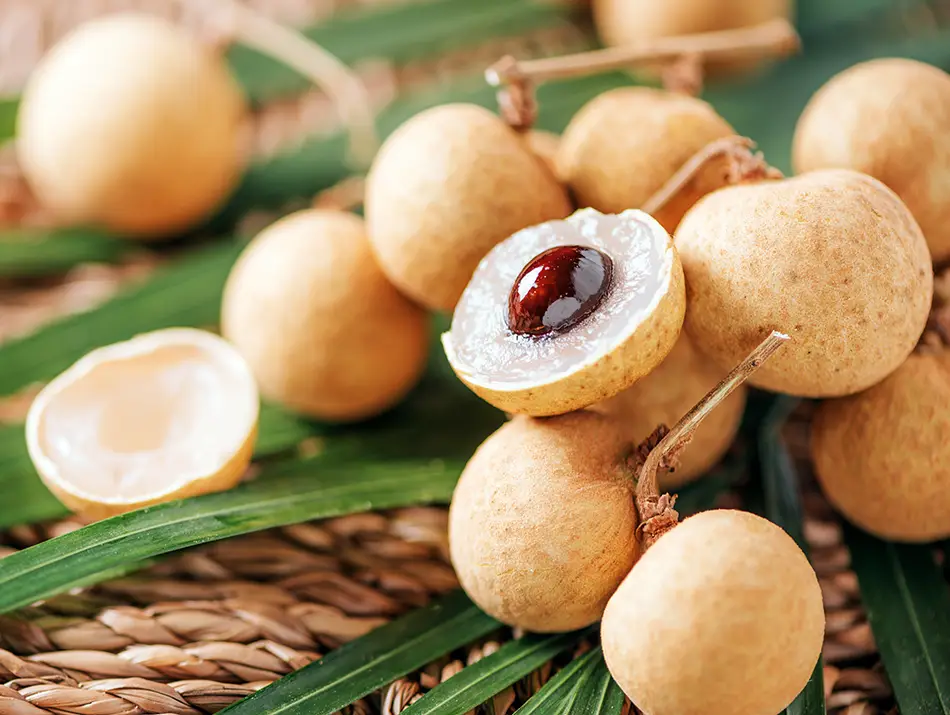
Average price: 50,000 VND per kg ($1.90 / €1.64). Premium Hung Yen longan often averages about 100,000 VND per kg ($3.80 / €3.30).
Longan is small and tan with translucent flesh around a dark seed. The main longan season is June to August. Premium orchards in Hung Yen province supply higher-priced varieties.
Longan is eaten fresh, dried as snacks, or simmered in sweet soups.
Lychee (vải)

Average price: 35,000 VND per kg ($1.33 / €1.15).
Lychee has a rough red skin and a white juicy interior with a large seed. It is one of the most searched Vietnam fruits because of its short but intense season. The main harvest runs from late May through July, tied closely to Bac Giang province, especially Luc Ngan district.
Lychee is eaten fresh or used in drinks and desserts. In harvest areas, visitors can join orchard picking during peak weeks, which is one of the best places to try fruits in Vietnam directly at the source.
Salak / Snake fruit (trái Mây)

Average price: 60,000 VND per kg ($2.28 / €2.02).
Salak, often called snake fruit because of its reddish-brown scaly skin, is a small pointed fruit with firm segments inside. Although not native to Vietnam, it is grown in limited quantities in the south and also reaches local markets through Cambodia and Thailand. The texture is crisp with a slightly dry, astringent finish, which makes it different from most soft exotic fruits in Vietnam.
To eat Salak, locals pinch the tip to loosen the skin, peel away the scales, and separate the firm beige segments.
Pomelo (bưởi)
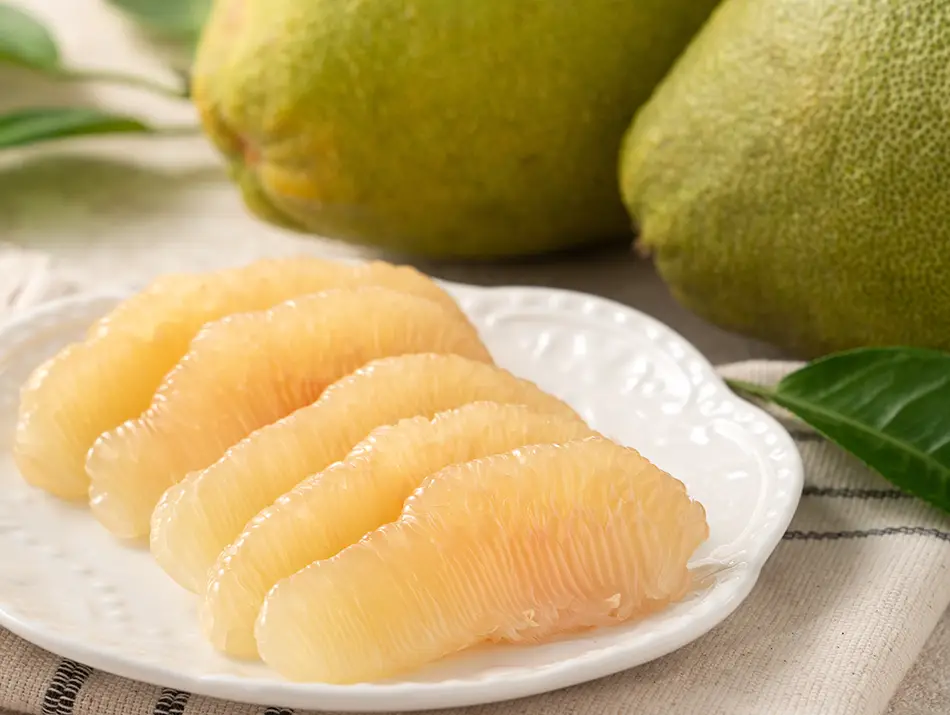
Average price: 50,000 VND per fruit ($1.90 / €1.64).
Pomelo is a large citrus fruit with thick rind and pale yellow or pink segments. It is available year-round, but peak quality is usually October to February, when demand rises for Tet and gifting. Several regions claim notable varieties, including provinces in the Mekong Delta and central Vietnam.
Pomelo takes time to peel because of the thick pith. You will sometimes see pre-peeled pomelo bags in markets, which save time but cost more.
Jackfruit (mít)

Average price: 20,000 VND per kg ($0.76 / €0.66).
Jackfruit is the largest tree fruit sold widely in Vietnam, often weighing 10–30 lb (5–14 kg). Its soft yellow pods surround large seeds and are eaten as a sweet snack, added to mixed fruit cups, or used in simple home desserts. The firm green stage is used as a vegetable in stews and salads and appears in some of the best Vietnamese dishes. The main harvest runs from January to June in many southern and central areas, although jackfruit is available year-round.
It is usually sold already cleaned, because opening a whole fruit is messy and sticky.
Special Places Every Fruit Lover Must Visit in Vietnam

If you want to go beyond city markets and eat fruits close to where they are grown, these destinations give the most direct access.
Mekong Delta homestead orchards and canals (Tien Giang, Ben Tre, Vinh Long)
The Mekong Delta is Vietnam’s main fruit belt, with dense canals and small family orchards. Tien Giang, Ben Tre, and Vinh Long provinces supply rambutan, durian, mangosteen, pomelo, longan, and star apple in season. Many homestays include orchard walks or boat trips that stop for fruit tasting.
Dragon fruit plantations around Phan Thiet and Binh Thuan
Former Binh Thuan province (Muine, Phantiet) has the country’s largest dragon fruit growing area. At night, some farms use lighting to stimulate off-season blooms, so you can see illuminated fields stretching across the dry coastal land. The effect looks almost like long rows of Christmas lights, which makes the area unusually striking after dark.
Lái Thiêu fruit orchards (near Ho Chi Minh City)
Lai Thieu sits about 20–25 mi (30–40 km) from Ho Chi Minh City. It is known for mangosteen, durian, and other southern fruits during summer harvest, which makes it one of the best places to try fruits in Vietnam without leaving the south’s main urban hub.
Vietnamese Fruit Season Chart

Season timing shifts slightly by province and year. This table shows the typical peak months to know when each type of Vietnamese fruits is usually at its best.
| Fruit | Main peak season | Main regions |
|---|---|---|
| Dragon fruit (thanh long) | July to December | Former Binh Thuan, Long An, Tien Giang |
| Rambutan (chôm chôm) | May to August | Mekong Delta, Southeast |
| Mangosteen (măng cụt) | May to August | Mekong Delta, Binh Duong |
| Durian (sầu riêng) | June to August in the south, shorter in the north | Mekong Delta, Central Highlands |
| Star apple (vú sữa) | November to January, extending into March | Southern provinces |
| Soursop (mãng cầu) | Year-round, stronger June to September | South and Central |
| Custard apple (na) | September to December | North and Central |
| Rose apple (roi/mận) | November to June | South, Mekong Delta |
| Longan (nhãn) | June to August | Hung Yen, Mekong Delta |
| Lychee (vải) | Late May to July | Bac Giang and northern provinces |
| Pomelo (bưởi) | October to February | Mekong Delta and Central |
| Jackfruit (mít) | January to June for ripe fruit | South and Central |
Practical Tips Every Traveler Needs
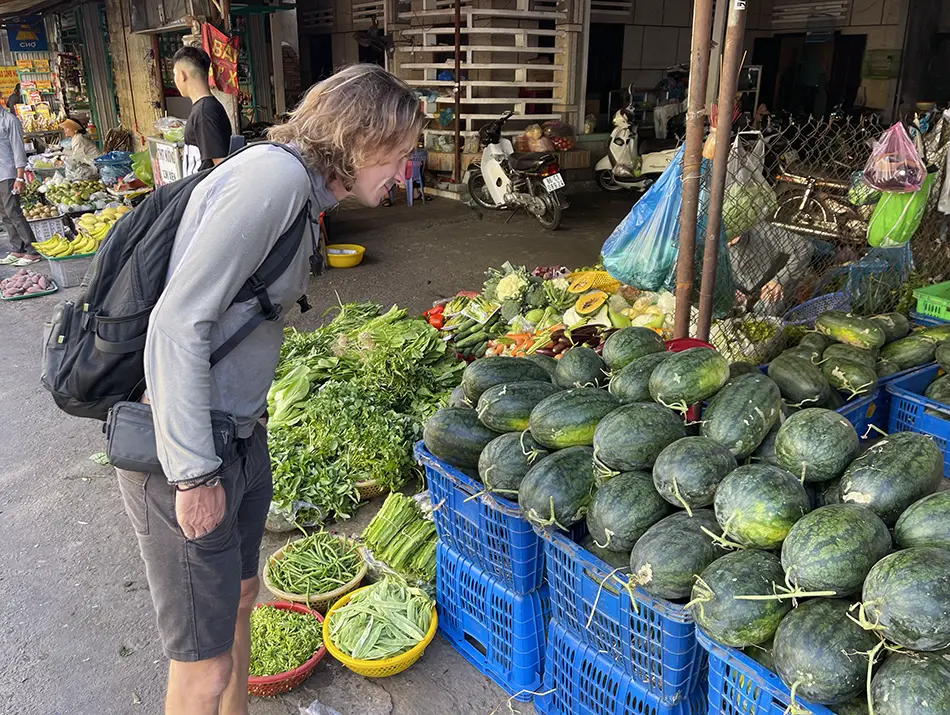
Ask for ready-to-eat fruit.
Tourist-oriented markets sell underripe fruit meant for taking home, so make sure to ask the vendor for something that is ready to eat on the same day.
Carry tissues.
Mangosteen rind stains purple, dragon fruit can tint fingers pink, and jackfruit latex is sticky. Many vendors do not provide anything beyond a plastic bag.
Be cautious with pre-cut fruit cups.
They save time, but freshness depends on how long the fruit has been exposed to heat. If you have a sensitive stomach, choose fruit you can peel yourself, such as rambutan, longan, or lychee.
Expect a Tet price bump.
In the weeks before Tet, altar and gifting demand pushes up prices for bananas, pomelo, mango, and other display fruits. Plan your fruit shopping before the holiday if you want lower prices.
Respect smell rules.
Durian is the main fruit with transport and hotel limits. If you buy it, eat it outdoors or in open-air areas to avoid problems with accommodation or drivers.
Vietnamese Fruits Q&A

Prices vary by season and region, but most popular fruits cost between 20,000 and 70,000 VND per kg ($0.80–$2.80). Specialty varieties such as premium longan or off-season mangosteen cost more. Prices rise before Tet due to gifting demand.
Most countries restrict fresh fruit imports due to agricultural regulations. Travelers can usually bring processed or dried fruit, but not fresh whole fruit. Check the destination’s customs guidelines before your flight.
The chili-salt mix balances mild or crisp fruits. It adds a salty and spicy edge to guava, green mango, and rose apple. This contrast is part of everyday snacking in Vietnam, especially in the south, where fruit is eaten throughout the day rather than as dessert.
Fruit seasons vary by month and region. In general, May to August is peak for rambutan, mangosteen, lychee, and longan. October to February is strong for pomelo. Dragon fruit appears year-round. Southern provinces have a longer growing season, so markets there usually offer the widest mix.
Conclusion
Trying Vietnamese fruits is an easy extra layer to the trip. You will run into them anyway in markets, on sidewalks, and at breakfast tables, so tasting a few takes no planning. The point is simple: many of these fruits are hard to find fresh in Europe or the US, and in Vietnam they are cheaper, riper, and more varied.
Pick what is in season where you are, and you will usually get the best flavor for the lowest price. Start with low-effort options you can peel yourself, then move to short-season fruits when you spot them at markets. If you check ripeness and avoid pre-cut fruit that has been sitting in heat, fruit tasting stays straightforward and adds something real to the food side of your Vietnam days.
For more practical insights on destinations, food, and culture, explore our full collection of Vietnam travel guides.

